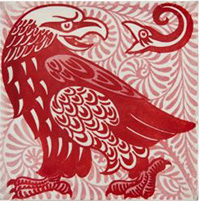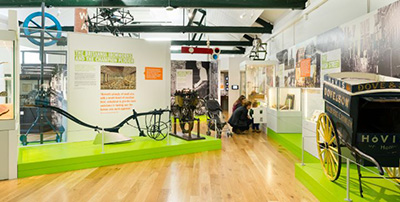Visitors can enjoy watercolour, print and decorative art collections of international significance, including major collections of works by William Burges and Edward Bawden. Local collections tell the story of Bedford and its people through archaeological finds, natural history, geology and social history. Important too are small but significant world archaeology and ethnography collections.
William Burges

William Burges, one of the most imaginative architects of the 19th Century, filled his buildings with richly-painted furniture, metalwork, ceramics and stained glass, all with his unique take on medieval style. The William Burges Gallery will feature the art gallery and museum's world-renowned collection of painted furniture designed by Burges for his own use, including his Sleeping Beauty Bed and the newly acquired Zodiac Settle, a detail of which is pictured above.
Edward Bawden Gallery
The artist and designer, Edward Bawden, was one of the most influential artists of his generation. With regular changing exhibitions and study days the gallery will provide an excellent resource and a fascinating insight into this great artist’s work.

Edward Bawden (1903 - 1989) Liverpool Street Station 1960, linocut
© The Edward Bawden Estate

The Design gallery features some of the greatest designers of the past 500 years from the decorative art collections of Cecil Higgins and Charles and Lavinia Handley-Read. Highlighting some of Britain’s most important stylistic movements from Rococo to Gothic Revival and Neo-Classical to Arts and Crafts the focus will be on manufacturing techniques and influences. Notable exhibits in the Design gallery include: Morris & Co textiles, Voysey furniture, William de Morgan ceramics and the metalwork of W.A.S. Benson, Liberty & Co furniture and dresses, enamels by Alexander Fisher, metalwork by John Paul Cooper and glass from Whitefriars. George Ravenscroft’s lead glass, wine glasses for and against the Jacobite cause, Irish cut glass and European and English porcelain including Johann Joachim Kändler for Meissen, Franz Anton Bustelli for Nymphenburg, and early Chelsea, Derby and Bow.
Tile, designed by William De Morgan c.1900
The Higgins House

The Higgins’ home remained in the family for almost a hundred years. The displays introduce the family and explore Cecil Higgins’ collection in terms of how the objects might have originally been used and what they said about the people that owned them. Downstairs, star items from the porcelain collection such as the Chelsea Swan Tureen will be displayed on the dining table illustrating the Georgian’s elaborate dining rituals and dozens of teapots and teacups will be on display in the morning room looking at the traditions of tea drinking. Upstairs the lives of women like those of the Higgins’s family are shown through the collections of jewellery, scent bottles and costume.
Image: Tureen in the form of two pigeons, Chelsea, 1752-1756
Please note for the week of 15 January, Settlement Gallery will be closed due to building work.

This gallery highlights the human journey through time. Objects, collections and people tell their own exciting story about Bedford, its rivers and its countryside. Our incredible journey begins millions of years ago when the land was covered by ancient seas, inhabited by strange life forms including sea monsters, and reveals the forces of nature that have shaped our landscape. With the emergence of solid land new creatures including early humans began to inhabit our region.
Through the objects on display we can begin to understand how people worked, lived, played and worshipped from the earliest times up to the Middle Ages. Intertwined within this thread are invaders from now lost empires, seafarers who came to raid and trade, powerful religious houses and vanishing castles. The gallery focuses on some of the most important stories drawn from our archaeological collections.
Saxon Window Urn, 400 - 500 AD, found in Kempston

This gallery continues the story of Bedfordshire and its people's history. It explores Bedford and its growth from a small but busy medieval market town to a centre of industry and business today. Bedfordshire's agricultural and engineering heritage is celebrated with a focus on J. & F. Howard's Britannia Ironworks, W. H. Allen's Queen's Engineering Works, and the brickworks. The town, countryside and people who live in Bedfordshire have changed significantly over the centuries. The displays feature local people and show how they have responded to events, including the Agricultural Revolution, the coming of the railways, the growth of Victorian Bedford, the development of the Airships at Cardington, the Second World War, newcomers looking for work and modern commercial and technology industries. The name of the gallery refers to Bedford as a wartime location for the evacuation of the music and religious departments of the BBC during the Second World War when they sent broadcasts from ‘Somewhere in England’.
Great Bedfordians

The Great Bedfordians gallery celebrates the contributions of men and women from Bedford and the surrounding area. Here you will find the stories of well-known people include the non-conformist preacher and author of the Pilgrim’s Progress John Bunyan, the prison reformer John Howard and founder of the Panacea Society Mabel Barltrop. There are also stories for lesser known individuals who have contributed much locally and nationally, including soldier and hot-air balloonist Col. Frederick Burnaby, schoolmistress and Suffragist Amy Walmsley, Sister Fanny Eagles of St. Etheldreda’s orphanage, and the poet Robert Bloomfield. ‘New Bedfordians’, people who have lived and worked here during the 20th century, are also featured, with their stories exploring how Bedfordshire has developed in to the place we know and love today.
Portrait of Colonel Frederick Burnaby (1842-1885) by David Litchfield, 2012
Collectors
This new gallery explores the origins of our collections and reveals how museums collect. Displays will compare methods of collecting from the latest archaeological research in Bedford, including a recreated excavation of a Bronze Age burial, to the work of the extraordinary amateur Victorian collectors to whom modern methodology owes so much. By displaying previously unseen ethnographic collections, The Higgins will also reveal long-lost stories from Bedford's past.
We also have new spaces for temporary exhibitions. Read more about our exhibitions programme here.